Implicit and explicit categorization: a tale of four species
- PMID: 22981878
- PMCID: PMC3777558
- DOI: 10.1016/j.neubiorev.2012.09.003
Implicit and explicit categorization: a tale of four species
Abstract
Categorization is essential for survival, and it is a widely studied cognitive adaptation in humans and animals. An influential neuroscience perspective differentiates in humans an explicit, rule-based categorization system from an implicit system that slowly associates response outputs to different regions of perceptual space. This perspective is being extended to study categorization in other vertebrate species, using category tasks that have a one-dimensional, rule-based solution or a two-dimensional, information-integration solution. Humans, macaques, and capuchin monkeys strongly dimensionalize perceptual stimuli and learn rule-based tasks more quickly. In sharp contrast, pigeons learn these two tasks equally quickly. Pigeons represent a cognitive system in which the commitment to dimensional analysis and category rules was not strongly made. Their results may reveal the character of the ancestral vertebrate categorization system from which that of primates emerged. The primate results establish continuity with human cognition, suggesting that nonhuman primates share aspects of humans' capacity for explicit cognition. The emergence of dimensional analysis and rule learning could have been an important step in primates' cognitive evolution.
Copyright © 2012 Elsevier Ltd. All rights reserved.
Figures
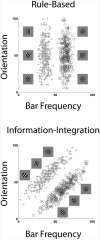
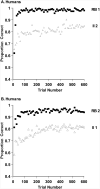
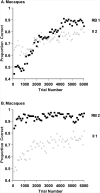
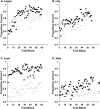
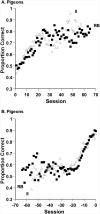
Similar articles
-
Implicit and explicit category learning by capuchin monkeys (Cebus apella).J Comp Psychol. 2012 Aug;126(3):294-304. doi: 10.1037/a0026031. Epub 2011 Oct 24. J Comp Psychol. 2012. PMID: 22023264 Free PMC article.
-
Pigeons' categorization may be exclusively nonanalytic.Psychon Bull Rev. 2011 Apr;18(2):414-21. doi: 10.3758/s13423-010-0047-8. Psychon Bull Rev. 2011. PMID: 21327382 Free PMC article.
-
Implicit and explicit category learning by macaques (Macaca mulatta) and humans (Homo sapiens).J Exp Psychol Anim Behav Process. 2010 Jan;36(1):54-65. doi: 10.1037/a0015892. J Exp Psychol Anim Behav Process. 2010. PMID: 20141317 Free PMC article.
-
The neuroscience of perceptual categorization in pigeons: A mechanistic hypothesis.Learn Behav. 2018 Sep;46(3):229-241. doi: 10.3758/s13420-018-0321-6. Learn Behav. 2018. PMID: 29532328 Review.
-
Multiple systems of category learning.Neurosci Biobehav Rev. 2008;32(2):249-64. doi: 10.1016/j.neubiorev.2007.07.009. Epub 2007 Aug 15. Neurosci Biobehav Rev. 2008. PMID: 17904637 Free PMC article. Review.
Cited by
-
Mouse visual cortex areas represent perceptual and semantic features of learned visual categories.Nat Neurosci. 2021 Oct;24(10):1441-1451. doi: 10.1038/s41593-021-00914-5. Epub 2021 Sep 20. Nat Neurosci. 2021. PMID: 34545249 Free PMC article.
-
Exploring Explicit Learning Strategies: A Dissociative Framework for Research.New Ideas Psychol. 2021 Jan;60:100817. doi: 10.1016/j.newideapsych.2020.100817. Epub 2020 Aug 8. New Ideas Psychol. 2021. PMID: 34121802 Free PMC article.
-
Selective attention, diffused attention, and the development of categorization.Cogn Psychol. 2016 Dec;91:24-62. doi: 10.1016/j.cogpsych.2016.09.002. Epub 2016 Oct 7. Cogn Psychol. 2016. PMID: 27721103 Free PMC article.
-
Breaking the perceptual-conceptual barrier: Relational matching and working memory.Mem Cognit. 2019 Apr;47(3):544-560. doi: 10.3758/s13421-018-0890-9. Mem Cognit. 2019. PMID: 30632014 Free PMC article.
-
Cognition: The power of simple associative learning.Curr Biol. 2023 Mar 27;33(6):R223-R225. doi: 10.1016/j.cub.2023.01.062. Curr Biol. 2023. PMID: 36977383 Free PMC article.
References
-
- Ahn W, Medin DL. A two-stage model of category construction. Cognitive Sci. 1992;16:81–121.
-
- Ashby FG, Alfonso-Reese LA, Turken AU, Waldron EM. A neuropsychological theory of multiple systems in category learning. Psychol Rev. 1998;105:442–481. - PubMed
-
- Ashby FG, Ell SW. The neurobiology of human category learning. Trends Cognitive Sci. 2001;5:204–210. - PubMed
-
- Ashby FG, Ennis JM, Spiering BJ. A neurobiological theory of automaticity in perceptual categorization. Psychol Rev. 2007;114:632–656. - PubMed
-
- Ashby FG, Gott RE. Decision rules in the perception and categorization of multidimensional stimuli. J Exp Psychol Learn Mem Cogn. 1988;14:33–53. - PubMed
Publication types
MeSH terms
Grants and funding
LinkOut - more resources
Full Text Sources

